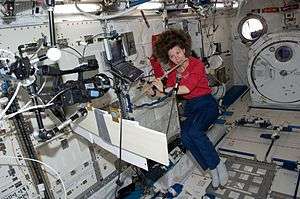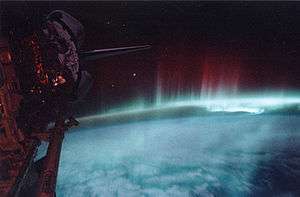Music in space

Music in space is music in outer space, related typically to the playing of sounds in human spaceflight, but also sometimes related to un-manned missions.[1] Music in space has been a focal point of public relation events of various spaceflight program missions.[1] An example of a NASA incorporating music in space when Astronaut Chris Hadfield filmed himself playing David Bowie's song Space Oddity on the International Space Station in 2013, and then uploaded it to the Internet Website YouTube.[1]
In the 1970s music on tape cassettes were brought to the U.S. Space Station Skylab.[2] An example of the Soviet's execution of music in space is when they allowed Aleksandr Laveikin and Yuri Romanenko to take a guitar to the space station Mir in 1987.[1]
In 2016 NASA released sound recordings of what Apollo 10 astronauts reported as sounding like "space music" on their radio.[3]
"The strangest thing about playing music in space is that it's not strange. In most homes, there's a musical instrument or two. And I think it's fitting that in a home in space you have musical instruments as well. It's natural.""Music makes it seem less like a space ship, and more like a home.
— Astronaut Carl Walz[4]
Walz played a rendition of the song Heartbreak Hotel abourd the ISS in 2003, and this was recorded and transmitted to Earth also.[4] Musical instruments need to be checked for gases they may emit before being taken aboard the confined space of the ISS.[4] Instruments that have been aboard ISS by 2003 include a flute, keyboard guitar, a saxophone, and a didgeridoo.[4]
Gemini 6A

Upon achieving a space rendezvous in Earth orbit between two manned spacecraft on Gemini 6A in December 1965, the sound of "Jingle Bells" was heard played on an 8-note Hohner "Little Lady" harmonica and a handful of small bells.[5][6] The Smithsonian Institution claims these were the first musical instruments played in space [7] and keeps the instruments on display and a visual image is also posted on their website.[8] It was donated to the museum in 1967, with Wally noting it "..plays quite well".[8]
Apollo 17
A few bars of The Fountain in the Park were sung on the Moon by NASA Astronauts Harrison Schmitt and Eugene Cernan on the 1972 Apollo 17 mission. Schmitt started by singing "I was strolling on the Moon one day..." when Cernan joined in. Cernan kept with the original "merry month of May", however, while Schmitt sang "December", which was the actual date at the time. After a brief debate, Schmitt resumed, singing "When much to my surprise, a pair of bonny eyes..." until he could no longer remember the lyrics and began vocalizing the notes instead. Moments later, Capsule Communicator Robert A. Parker cut in from Houston, saying "sorry about that, guys, but today may be December."
Voyager Golden Record
The Voyager program probes Voyager 1 and Voyager 2 which by 2016 were still the farthest human made object from Earth (also Voyager 1 is reported to have reached interstellar space) where the galactic plasma is present.[9] Voyager 1 and Voyager 2 were launched by NASA with a message aboard — a kind of time capsule, intended to communicate to extraterrestrials a story of the world of humans on Earth.[10]
This is a present from a small, distant world, a token of our sounds, our science, our images, our music, our thoughts and our feelings. We are attempting to survive our time so we may live into yours.
Audio sections contain the spoken greetings in the remaining four languages, including Esperanto and !Kung, and also whale sounds were provided by Roger Payne.[11] The next audio section is devoted to the "sounds of Earth" that include:[12]
|
Included within the Sounds of Earth audio portion of the Golden Record is a track containing the inspirational message per aspera ad astra in Morse Code. Translated from Latin, it means, through hardships to the stars.
Beagle 2 and Blur
In 2003 the British space organization's Beagle 2 probe was scheduled to play a song from the UK music band Blur, upon touchdown on the planet Mars.[13] It was not known what happened to Beagle for 11 years after its landing, and was considered a lost, but when it was found 2015 intact it raised the possibility that it had successfully played the song on Christmas day in 2003 when it landed, but failed to transmit back to Earth.[14]
Curiosity rover and Reach for the Stars
A song written, produced and recorded by American recording artist will.i.am in commemoration of the landing of the Curiosity rover on the planet Mars called "Reach for the Stars", alternately subtitled "Mars Edition" and "NASA Edition", was first released on August 28, 2012. This song "Reach for the Stars (Mars Edition)" became the first song in history to be broadcast from another planet, completing a journey of more than 300 million miles between Mars and Earth.[15]
References
- 1 2 3 4 "Tuned in: music of the Soviet space programme". sciencemuseum.org.uk. Retrieved November 4, 2016.
- ↑
- ↑ "Nasa releases recording of strange 'space music' heard by Apollo 10 astronauts".
- 1 2 3 4 "Space StationMusic - NASA Science".
- ↑ "NASA Mum on 'Jingling'", Palm Beach Post, Dec 17, 1965
- ↑ The Song from Outer Space on YouTube
- ↑ Smithsonian magazine, December 2005
- 1 2 "Harmonica, Gemini 6". 20 March 2016.
- ↑ "NASA Spacecraft Embarks on Historic Journey Into Interstellar Space". http://www.nasa.gov. NASA. September 12, 2013. Retrieved April 15, 2014. External link in
|website=(help) - ↑ "Voyager – Golden Record". NASAaccessdate= September 23, 2010.
- ↑ Gambino, Megan (April 23, 2012). "What Is on Voyager's Golden Record?". Smithsonian Magazine. Retrieved November 19, 2012.
- ↑ "Voyager – Spacecraft – Golden Record – Sounds of Earth". NASA. Retrieved August 17, 2008.
- ↑ "Listen to the music that the Beagle 2 probably played on Mars in 2003 - The Verge". theverge.com. Retrieved November 4, 2016.
- ↑ Vincent, James (16 January 2015). "Listen to the music that the Beagle 2 probably played on Mars in 2003".
- ↑ Karimi, Faith (August 29, 2012). "Will.i.am premieres song -- from Mars". CNN. Retrieved January 25, 2014.
See also
- Space-themed music (is Music related to outer space)
- Space music (a genre of Music type)
